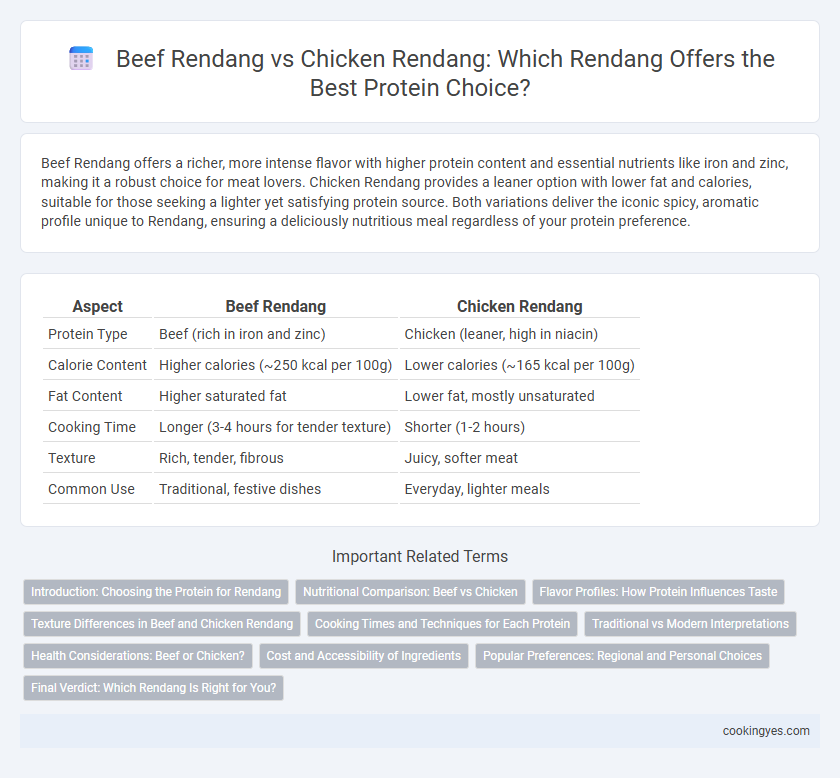Beef Rendang offers a richer, more intense flavor with higher protein content and essential nutrients like iron and zinc, making it a robust choice for meat lovers. Chicken Rendang provides a leaner option with lower fat and calories, suitable for those seeking a lighter yet satisfying protein source. Both variations deliver the iconic spicy, aromatic profile unique to Rendang, ensuring a deliciously nutritious meal regardless of your protein preference.
Table of Comparison
| Aspect | Beef Rendang | Chicken Rendang |
|---|---|---|
| Protein Type | Beef (rich in iron and zinc) | Chicken (leaner, high in niacin) |
| Calorie Content | Higher calories (~250 kcal per 100g) | Lower calories (~165 kcal per 100g) |
| Fat Content | Higher saturated fat | Lower fat, mostly unsaturated |
| Cooking Time | Longer (3-4 hours for tender texture) | Shorter (1-2 hours) |
| Texture | Rich, tender, fibrous | Juicy, softer meat |
| Common Use | Traditional, festive dishes | Everyday, lighter meals |
Introduction: Choosing the Protein for Rendang
Beef Rendang offers a rich, hearty flavor and higher protein content, making it a popular choice for those seeking a robust and satisfying meal. Chicken Rendang provides a leaner alternative with slightly less fat and calories, suitable for health-conscious individuals aiming for a lighter protein option. Both proteins absorb the complex spices of rendang, but beef's texture holds up better to the slow-cooking process, enhancing its tender and savory profile.
Nutritional Comparison: Beef vs Chicken
Beef rendang typically offers higher protein content and essential minerals like iron and zinc compared to chicken rendang, making it a dense source of muscle-building nutrients. Chicken rendang provides leaner protein with lower saturated fat, suitable for those seeking heart-healthy options. Both rendang types deliver rich amino acids, but beef rendang supports greater caloric energy and micronutrient density essential for endurance and recovery.
Flavor Profiles: How Protein Influences Taste
Beef Rendang offers a rich, robust flavor with a deep umami profile that develops through slow cooking, intensifying the meat's natural savory notes and absorbing the complex spices of lemongrass, galangal, and coconut milk. Chicken Rendang delivers a lighter, more subtle taste that allows the aromatic herbs and spices to shine with a tender, juicy texture that contrasts the denser beef. Protein choice directly influences the Rendang's flavor intensity and mouthfeel, with beef providing a hearty, bold experience and chicken offering a delicate, fragrant interpretation of the traditional dish.
Texture Differences in Beef and Chicken Rendang
Beef Rendang offers a rich, tender texture due to slow-cooked, fibrous muscle that breaks down into succulent layers, creating a deeply satisfying mouthfeel. Chicken Rendang features leaner meat with a firmer, slightly chewy texture that contrasts with the creamy coconut sauce, providing a lighter protein option. Both versions absorb the spiced coconut gravy differently, enhancing their unique textural characteristics essential in authentic Rendang dishes.
Cooking Times and Techniques for Each Protein
Beef Rendang requires slow cooking over low heat for several hours to achieve tender, flavorful meat that absorbs the complex spices, while Chicken Rendang cooks faster, typically in under an hour, allowing the chicken to remain juicy without drying out. The tougher texture of beef benefits from prolonged simmering and reduction of coconut milk, resulting in a rich, caramelized sauce, whereas chicken demands gentler heat and careful timing to prevent overcooking. Both proteins rely on traditional spice blends, but cooking techniques differ significantly to optimize texture and flavor absorption for each choice.
Traditional vs Modern Interpretations
Beef Rendang, traditionally slow-cooked in coconut milk and a rich blend of spices, offers a robust and deeply infused protein experience prized in Minangkabau cuisine, while Chicken Rendang provides a lighter, faster-cooking alternative favored in modern adaptations for its versatility. Traditional Beef Rendang emphasizes lengthy simmering that enhances protein texture and flavor complexity, contrasting with contemporary Chicken Rendang recipes that often incorporate quicker cooking methods to suit busy lifestyles. Nutritionally, beef delivers higher iron and zinc content, whereas chicken rendang caters to those seeking leaner protein options without sacrificing the dish's hallmark savory richness.
Health Considerations: Beef or Chicken?
Beef rendang offers a richer source of protein and higher iron content, beneficial for muscle repair and energy levels, while chicken rendang typically contains fewer calories and less saturated fat, supporting heart health and weight management. Choosing chicken rendang may lower cholesterol intake and reduce the risk of cardiovascular diseases, whereas beef rendang provides essential nutrients like zinc and vitamin B12 for immune function. Health-conscious individuals should consider their dietary goals and nutritional needs when selecting between beef or chicken rendang for optimal protein benefits.
Cost and Accessibility of Ingredients
Beef Rendang typically contains higher protein content per serving compared to Chicken Rendang, but its ingredients like beef cuts are often more expensive and less accessible in some regions. Chicken Rendang offers a more affordable protein alternative with widely available chicken, making it a budget-friendly option without compromising traditional flavors. Both variants require similar spices, though the choice between beef or chicken impacts overall ingredient cost and availability significantly.
Popular Preferences: Regional and Personal Choices
Beef Rendang is favored in regions like West Sumatra and among those seeking a richer, more intense flavor profile with higher protein content. Chicken Rendang appeals to individuals preferring a lighter, leaner option while still enjoying traditional spices and texture. Personal preferences and cultural influences significantly shape the choice between beef and chicken protein in Rendang dishes.
Final Verdict: Which Rendang Is Right for You?
Beef Rendang offers a rich, intense flavor and higher protein content, making it ideal for those seeking a hearty, protein-dense meal. Chicken Rendang provides a lighter, leaner alternative with slightly less fat, suitable for individuals prioritizing lower calorie intake without sacrificing savory taste. Your choice depends on dietary goals and flavor preference, as both rendangs deliver authentic Indonesian spices and protein benefits.
Beef Rendang vs Chicken Rendang for protein choice Infographic

 cookingyes.com
cookingyes.com